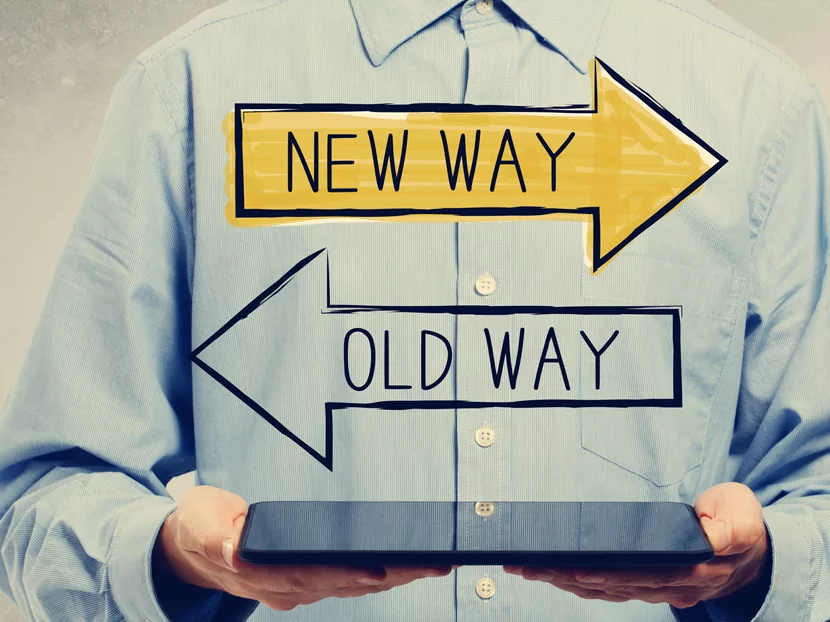A 2020 McKinsey study estimated an enormous increase in e-commerce deliveries. Within a span of eight weeks in 2020, it is as if 10 years of technology adoption occurred. Online education also made an incredible jump, as 250 million students adjusted to remote learning in two weeks. The COVID-19 pandemic forced many industries to adapt to noncontact business technologies. What will be the lasting tech changes for the PHCPPROS audience?
Fortunately for our industry, the essential worker designation of plumbing and HVAC professionals kept us up and running to varying degrees during most of the pandemic. Additionally, you can fix a leaky faucet over Zoom. However, a certain amount of work in our industry will always need to be done in person. What additional support and logistical topics would benefit from modernization?
At the wholesale level, point-of-purchase advertising fell from prime real estate for product advertising in 2019 to something rarely seen by customers for most of 2020. In the distributor branches where employees only delivered product to customers at the curb, key impulse buy products lost visibility. Expensive end caps, working displays, posters and counter mats may have collected dust all year.
Will those point of purchase displays be updated in 2021? Where else would you find new information about a product? The short answer is that you are more likely to see something new on social media, now more than ever.
The advantage of discovering a new product or tool on social media is that you are likely to see it in action. Instead of noticing a new item at a wholesale counter and taking a leap of faith to buy it, you may see a fellow contractor solve a problem or speed up a task with the item in a video demonstration. This level of confidence that a product will help you immediately is hard to accomplish with a one-page sell sheet.
Face-to-face vs. no-contact sale
For the products customers may have already known and purchased before the pandemic, a smooth online purchase with curbside or jobsite delivery may have gone from an occasional convenience to the norm. This may call for some soul searching in the wholesale industry.
Would a distributor in 2022 be better off with a giant showroom and 10 inside sales workers lined up at computers, or with three drive-through lanes for order pickup outside a distribution center? Amazon plans to build 1,000 new delivery hubs and warehouses across the United States to keep up with its shipping demands, notes freight transportation magazine Transport Topics (http://bit.ly/3d11nf7). Will plumbing and heating distribution follow this business model?
Taking a step further back, an enormous amount of business was still conducted face-to-face within the PHCP industry in 2019. Training, new catalog handoffs and product demonstrations were among the many in-person deliverables. Will that still be the case in a post-COVID vaccine world? Many engineering firms and corporate offices only allow salespeople to stop by with an appointment, if at all.
The bigger question is this: Do these companies want the casual, drop-by-any-time salespeople back?
I worked as a manufacturers’ rep for a few years. One of the cities in my territory was fairly remote. The branch managers of the wholesale locations in the area mentioned that they sometimes didn’t see reps for six months. They all knew there was one specific day on the calendar where they would be bombarded with visitors.
One of the distributors in this city hosted an annual golf tournament. All the manufacturers and reps would descend on that day and stop at the other competitor distributors in town while they were there. The result was a line of reps from dozens of companies waiting their turn to discuss six months’ worth of new product details, buying programs, marketing plans or anything else before their tee time.
If you are a wholesale manager or work in an engineering firm and notice those seasonal spikes, do you ever want to go back to business as usual? Is a prearranged webinar or a conveniently timed GoToMeeting a more effective process for both parties to get up to speed?
Freight logistics, driverless deliveries
Further down the road, what technologies could additionally accelerate our industry? Driverless freight deliveries may go from the occasional local news story about a crazy idea to a functional alternative in 2021. Tu Simple (www.tusimple.com/technology) is one of the logistics companies getting a lot of attention from investors such as UPS and VW. It claims it can deliver cargo safer with sensing technology that far surpasses the human eye. And the machines never get tired or need breaks.
Tu Simple further claims that cargo will be delivered more quickly and cautiously, resulting in 30 percent total freight savings. This technology could be significant for manufacturer-to-distributor shipping lanes within the year.
The rollout of the COVID-19 vaccines will also bring some interesting logistics technologies to light. FedEx will use a program called SenseAware ID with low-energy, Bluetooth technology to track the vaccine doses they ship, CNN reports (http://cnn.it/2Z5ZxRY).
Low energy is important to ensure battery life is long enough to survive the trip. Bluetooth is useful because it can be scanned by proximity to speed up inventory checks, so there is no need to directly scan each item like a traditional barcode. These sensors are attached to the vaccine batches to monitor the temperature and report the boxes’ location.
This type of technology would be overkill for most PHCP industry deliveries from the temperature monitoring standpoint. However, it would be useful to know if a condensing boiler that was live-fired during testing froze on the way to your jobsite before you piped it in and found the leak.
More interesting would be the live location of specific, critical packages. I imagine everyone reading this has lost something important in the mail and watched helplessly as the tracking number information flatlined. Instead, you
The rise of telemedicine
Another prominent trend in 2020 was the adoption of telemedicine. This isn’t directly related to the PHCP industry but could significantly affect our teams. The McKinsey data showed a tenfold increase in virtual appointments in 15 days.
If you work in the field, I imagine you have canceled, rescheduled or skipped many medical appointments over the years. It doesn’t matter if you have an appointment in an hour if you just found a pinhole leak at a customer’s house.
Could the adoption of this trend allow for a healthier workforce? If the doctor can meet you via iPhone in your truck outside of a jobsite, would you be more likely to keep the appointment and potentially catch something before it becomes a chronic issue that takes you off the job for weeks
Microsoft CEO Satya Nadella said of 2020, “We’ve seen two years’ worth of digital transformation in two months.” Some of these technology shifts may be temporary until we can safely organize in groups again. Some changes may have opened our eyes to a much easier, improved way of normal business.
2021 will be an interesting year to see how the scales balance between getting back to business as usual or continuing to springboard into new technologies. What new technology are you most excited about?
For additional information, visit these websites:
• “CES 2021: Tech Trends to Watch” presentation pdf, https://bit.ly/3aamXM7
• Harvard Business Review, “What Did 2020 Do to Retail?” http://bit.ly/3dhDeRJ






